NEC NaViSet Administrator Quick Start Guide
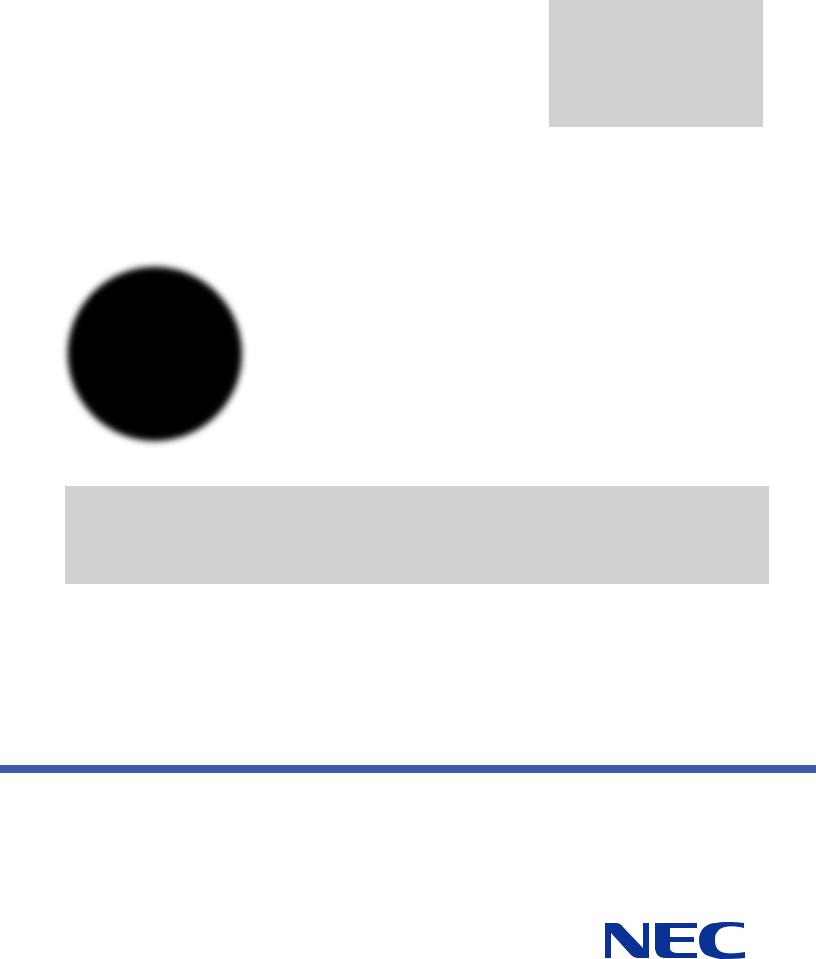
Version
2.0.11
 NaViSet Administrator 2
NaViSet Administrator 2
Quick Start Guide
English / Deutsch / Français / /

NaViSet Administrator 2
Quick Start Guide
English

NaViSet Administrator 2 - Quick Start Guide
1. ABOUT NAVISET ADMINISTRATOR 2 ..................................... |
3 |
1.1. SYSTEM REQUIREMENTS ........................................................... |
3 |
1.2. USER INTERFACE OVERVIEW ...................................................... |
4 |
1.3. GETTING STARTED.................................................................. |
7 |
2. PREPARING DEVICES ............................................................ |
8 |
2.1. NEC DESKTOP DISPLAYS .......................................................... |
8 |
2.2. NEC LARGE-SCREEN DISPLAYS .................................................. |
9 |
2.3. NEC PROJECTORS ................................................................ |
10 |
3. MAPPING THE NETWORK..................................................... |
11 |
3.1. CREATING GROUPS ............................................................... |
11 |
3.2. ADDING SINGLE DEVICES ....................................................... |
12 |
3.3. ADDING DAISY CHAINS OF NEC LARGE-SCREEN DISPLAYS ................. |
14 |
3.4. ADDING MULTIPLE DEVICES..................................................... |
16 |
3.5. CREDENTIAL LIBRARY ............................................................ |
17 |
4. QUERYING AND CONTROLLING DEVICES............................. |
18 |
4.1. QUERYING DEVICES .............................................................. |
18 |
4.2. CONTROLLING DEVICES.......................................................... |
19 |
5. CREATING AND RUNNING TASKS ........................................ |
21 |
5.1. CREATING TASKS ................................................................. |
23 |
Command Tasks.................................................................. |
23 |
Conditional Tasks ................................................................ |
24 |
Informational Tasks ............................................................. |
25 |
Email Notifications ............................................................... |
26 |
Scheduling Tasks................................................................. |
27 |
5.2. RUNNING TASKS .................................................................. |
28 |
5.3. TASK HISTORY .................................................................... |
29 |
6. CREATING AND RUNNING REPORTS.................................... |
30 |
6.1. CREATING REPORTS .............................................................. |
32 |
6.2. RUNNING REPORTS ............................................................... |
33 |
6.3. REPORT HISTORY ................................................................. |
33 |
English - 2

NaViSet Administrator 2 - Quick Start Guide
1. About NaViSet Administrator 2
NaViSet Administrator is a network based control and asset management system for NEC display monitors and projectors. With NaViSet Administrator you can:
•Automatically monitor the operational states and control settings of your NEC equipment.
•Send automatic email alerts of abnormal conditions such as overheating, cooling fan failure, and diagnostics errors.
•Access and adjust the numerous control settings of your NEC devices using interfaces similar to that of their On Screen Displays and remote control units.
•Monitor the operational states of both Windows-based computers connected to your network and single-board computers installed in your NEC displays.
•Create detailed reports of device assets, operational states and control settings and export them to popular spreadsheet formats.
About this Document
This document is intended to be used as a guide for introducing you to the basic operations of NaViSet Administrator. References like the one below appearing throughout this document will direct you to the associated topics in the NaViSet Administrator User's Guide, where you will find complete information.
 See chapter 1, "Introduction to NaViSet Administrator" in User's Guide
See chapter 1, "Introduction to NaViSet Administrator" in User's Guide
Note: The NaViSet Administrator User's Guide is currently available in English only.
1.1. System Requirements
Operating System |
32 and 64 bit versions of Microsoft Windows XP, Server 2003, Vista, Windows 7, |
|
and Windows 8. |
|
|
LAN |
Standard TCP/IP LAN interface. Static IP addresses required for most displays |
|
connected directly to LAN, unless name resolution (hostname) support is provided. |
|
|
System Resources |
At least 64MB available hard-disk space for installation. |
|
Approximately 50MB per 100 devices hard-disk space required for database |
|
storage. |
|
At least 96MB RAM (192MB recommended) |
|
|
Software |
Adobe Reader X or higher is recommended for viewing the User’s Guide. |
|
Open Hardware Monitor (optional) for monitoring computer temperature and fan |
|
status. |
|
|
|
English - 3 |

NaViSet Administrator 2 - Quick Start Guide
Supported Display Devices
NaViSet Administrator supports the following NEC display models:
•NEC desktop display models.
•NEC large-screen display models.
•NEC projector models with a LAN or RS232 connection.
Note: NEC E series of large-screen displays is not supported.
Please see the NEC website for the latest listing of specific models.
Supported features and functionality will depend on model.
1.2. User Interface Overview
Main Window
1 |
6 |
2
5
3 
|
|
|
|
4 |
|
|
|
|
1 |
Main Menu and Toolbar |
|
2 |
Device Tree |
|
3 |
Status Bar |
|
4 |
Dock Window Tabs |
|
5 |
Dock Window Area |
|
6 |
Dock Window Title Bar |
|
English - 4

NaViSet Administrator 2 - Quick Start Guide
Main Menu and Toolbar
The Main Menu consists of 8 sub-menus. A toolbar below the main menu provides convenient shortcuts to many functions.
File menu
 New - Creates a new database file.
New - Creates a new database file.
 Open... - Opens an existing database file.
Open... - Opens an existing database file.
 Save - Saves the current database file.
Save - Saves the current database file.
 Save As... - Saves the current database to a different file name.
Save As... - Saves the current database to a different file name.
Edit menu
 Copy - Copies data from the currently selected table to the Windows clipboard.
Copy - Copies data from the currently selected table to the Windows clipboard.
 Paste - Not currently used.
Paste - Not currently used.
 Delete - Deletes the currently selected group or device in the device tree. Rename - Renames the currently selected group or device in the device tree.
Delete - Deletes the currently selected group or device in the device tree. Rename - Renames the currently selected group or device in the device tree.
 Standard Device Info Update - Performs a Standard Update on the currently selected device tree items.
Standard Device Info Update - Performs a Standard Update on the currently selected device tree items.
Full Device Info Update - Performs a Full Update on the currently selected devices in the device tree. Cancel All Updates - Cancels all Standard or Full Updates that are currently being performed on any devices.
 Properties - Opens the Device Properties Window for the currently selected device in the device tree.
Properties - Opens the Device Properties Window for the currently selected device in the device tree.
View menu
Status Bar - Hides or shows the status bar at the bottom of the main window. Toolbars - Hides or shows the toolbar buttons.
Devices menu
 Add Single Device... - Adds a new device to the database. See 3.2. Adding Single Devices on page 12.
Add Single Device... - Adds a new device to the database. See 3.2. Adding Single Devices on page 12.
 Add Multiple Devices... - Adds several devices to the database. See 3.4. Adding Multiple Devices on page 16.
Add Multiple Devices... - Adds several devices to the database. See 3.4. Adding Multiple Devices on page 16.
 Add Group.... - Adds a new Group to the device tree. See 3.1. Creating Groups on page 11.
Add Group.... - Adds a new Group to the device tree. See 3.1. Creating Groups on page 11.
 Test Connection - Tests the connection to a device to make sure it is accessible on the network.
Test Connection - Tests the connection to a device to make sure it is accessible on the network.  Credential Library... - Opens the Credential Library. See 3.5. Credential Library on page 17.
Credential Library... - Opens the Credential Library. See 3.5. Credential Library on page 17.
Tasks menu
 New Task... - Creates a new Task. See 5. Creating and Running Tasks on page 21.
New Task... - Creates a new Task. See 5. Creating and Running Tasks on page 21.
 Task Builder Wizard... - Creates a new task using a wizard interface to guide.
Task Builder Wizard... - Creates a new task using a wizard interface to guide.
 Task Library... - Opens the Task Library.
Task Library... - Opens the Task Library.
 Show/Hide Alerts - Shows or hides the Alerts list.
Show/Hide Alerts - Shows or hides the Alerts list.
English - 5
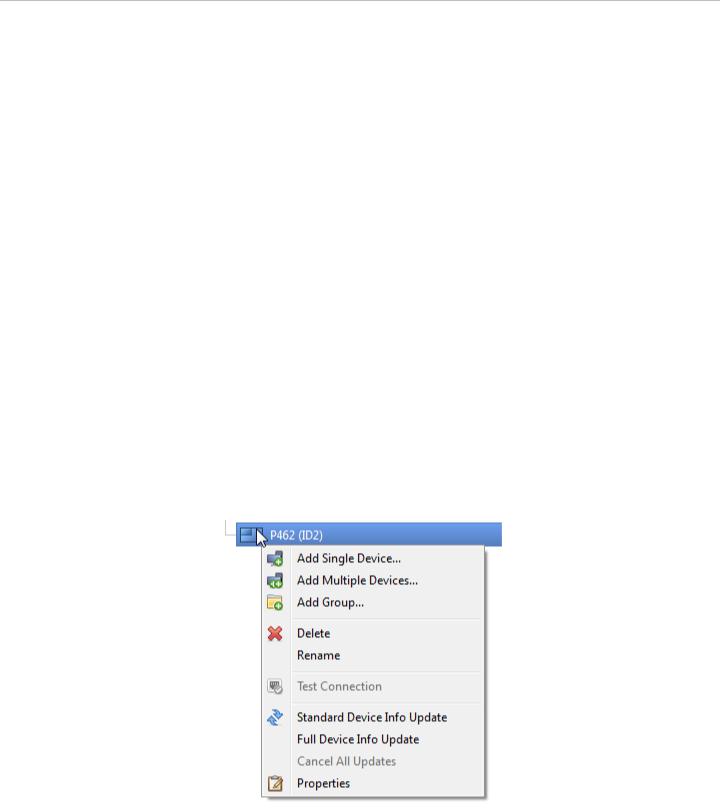
NaViSet Administrator 2 - Quick Start Guide
 Show/Hide Active Tasks - Shows or hides the Active Tasks list.
Show/Hide Active Tasks - Shows or hides the Active Tasks list.
 Show/Hide Inactive Tasks - Shows or hides the Inactive Tasks list.
Show/Hide Inactive Tasks - Shows or hides the Inactive Tasks list.
Reports menu
 New Report... - Creates a new Report. See 6. Creating and Running Reports on page 30.
New Report... - Creates a new Report. See 6. Creating and Running Reports on page 30.
 Report Library... - Opens the Report Library.
Report Library... - Opens the Report Library.
 Show/Hide Active Reports - Shows or hides the Active Reports list.
Show/Hide Active Reports - Shows or hides the Active Reports list.  Show/Hide Inactive Reports - Shows or hides the Inactive Reports list.
Show/Hide Inactive Reports - Shows or hides the Inactive Reports list.
Tools menu
 Preferences - Opens the application Preferences window.
Preferences - Opens the application Preferences window.
Help menu
 Help - Opens the online help system.
Help - Opens the online help system.
 Check for Updates - Checks with the NEC software update system to see if a newer version is available. An Internet connection is required.
Check for Updates - Checks with the NEC software update system to see if a newer version is available. An Internet connection is required.
About NaViSet Administrator 2... - Displays the software and database version information.
Device Tree
The Device Tree shows all of the displays and computers in the current database. Named folders, or Groups are used to organize devices in a logical way, for example by location or department.
The Device Tree contains a Context Menu which provides fast access to common operations. To open the Context Menu, right-click on a device. The Context Menu will open with the menu items enabled for the given device and current application state.
Device Tree Context Menu
English - 6

NaViSet Administrator 2 - Quick Start Guide
Dock Window Area
The Dock Window Area can contain any number of Dock Windows, which are stacked on top of one another and tabbed so you can easily identify and select them. You can also move dock windows outside of the main window to other locations on your desktop. To move a dock window, click and drag it's title bar. By default, NaViSet Administrator opens with two docked windows, Task Manager and Report Manager.
 See chapter 2, "User Interface Overview" in User's Guide
See chapter 2, "User Interface Overview" in User's Guide
1.3. Getting Started
The rest of this guide is divided into sections consisting of the main steps involved in a typical NaViSet Administrator implementation:
1.Prepare your Windows computers and NEC display devices for use with NaViSet Administrator. See Section 2: Preparing Devices.
2.Add Windows computers, NEC displays and NEC projectors to the device tree. See Section 3:
Mapping the Network.
3.Get detailed device information and control your devices interactively. See Section 4: Querying and Controlling Devices.
4.Create tasks to control, query and monitor the state of your devices. See Section 5: Creating and Running Tasks.
5.Create detailed reports of your device assets and settings. See Section 6: Creating and
Running Reports.
English - 7
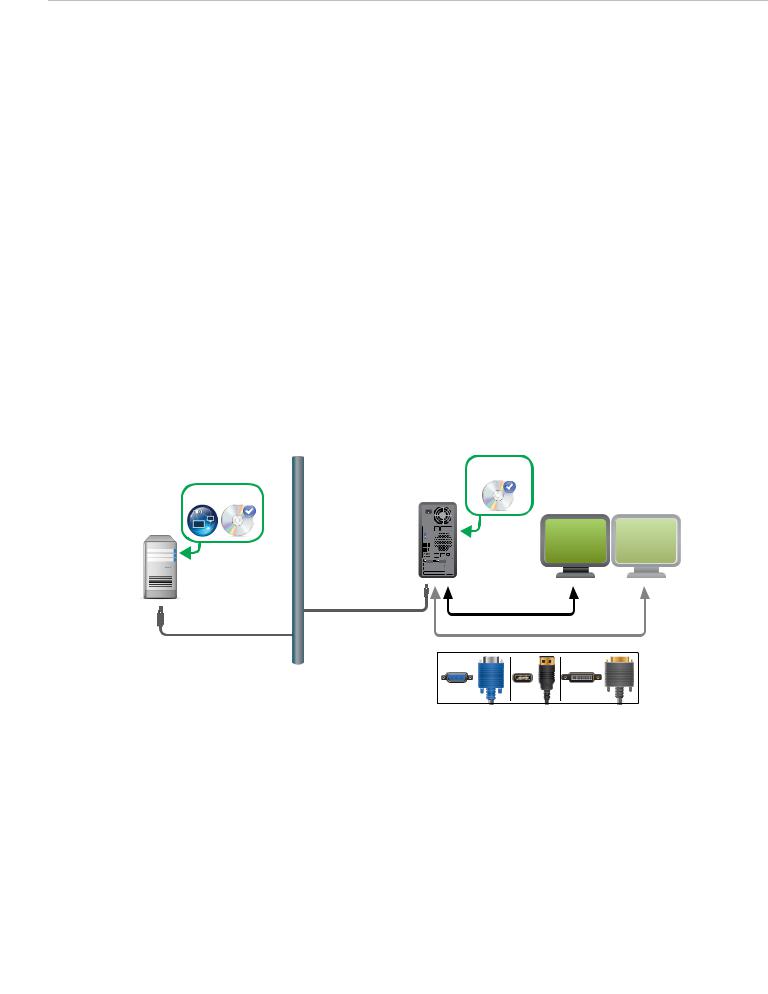
NaViSet Administrator 2 - Quick Start Guide
2. Preparing Devices
NaViSet Administrator supports the following types of networked devices:
•Windows computers and connected displays
•NEC large-screen displays
•NEC projectors
Before you can use NaViSet Administrator, the NEC display devices and Windows computers on your network need to be configured. Depending on how your devices are connected, the following issues may need to be addressed:
•Display devices are properly connected using the correct types of cables
•The necessary remote software components are installed and correctly configured on the Windows computers
•External communications settings are properly configured in the Large-screen displays and projectors.
NaViSet Administrator is designed to work with all types of network configurations involving NEC devices. The following sections contain some basic configuration diagrams used for desktop displays, large-screen displays and projectors.
2.1. NEC Desktop Displays
N
E
T
W
O
R
K
VGA/DisplayPort/DVI Connections
Key Points:
•The DDC/CI WMI Provider software should be installed on Windows computers hosting NEC desktop displays. The DDC/CI WMI Provider enables two-way communications with the displays connected to a computer.
•The computer's graphics card should support DDC/CI.
•The video connection is used for data communication, so no network connection settings are required in the display.
English - 8

NaViSet Administrator 2 - Quick Start Guide
See chapter 4, "Configuring Devices: Desktop display(s) connected to a Windows Computer" in User's Guide
2.2. NEC Large-Screen Displays
N |
|
|
|
|
|
E |
|
|
|
|
|
T |
|
|
|
|
|
W |
LAN1 |
RS-232C OUT |
|
RS-232C IN |
RS-232C OUT |
O |
|
||||
|
|
|
|
|
|
R |
|
|
|
|
|
K |
|
LAN2 |
OR |
LAN1 |
LAN2 |
|
|
|
Key Points:
•Additional displays can be daisy chained from the LAN-connected display via RS232 or LAN, depending on model.
•RS232 cables must be crossover/NULL modem type.
•The LAN Settings in the first display must be properly configured with valid IP Settings.
•For displays that use RS232 daisy chaining, the External Control setting of the first display must be set to LAN, and any additional daisy chained displays must be set to RS232.
•For displays that use RS232 daisy chaining, the Monitor IDs must be unique and consecutive (1, 2, 3,).
Note: Changes to the LAN Settings, External Control settings and Monitor IDs are made in the onscreen menu of each display. Refer to your display's user manual for more information.
See chapter 4, "Configuring Devices: NEC large-screen display(s) using direct LAN connection" and also "NEC large-screen display(s) with LAN hub using direct LAN connection" in User's Guide
Additional Large-Screen Configuration Types
NaViSet Administrator can also communicate with NEC large-screen displays connected to Windows computers via RS232. This is done by installing the LAN to RS232 Bridge software on the computer, allowing NaViSet Administrator to communicate with the display using the IP address of the computer.
An alternative method of communicating with NEC large-screen displays connected to Windows computers via RS232 is to use the RS232 WMI Provider.
English - 9
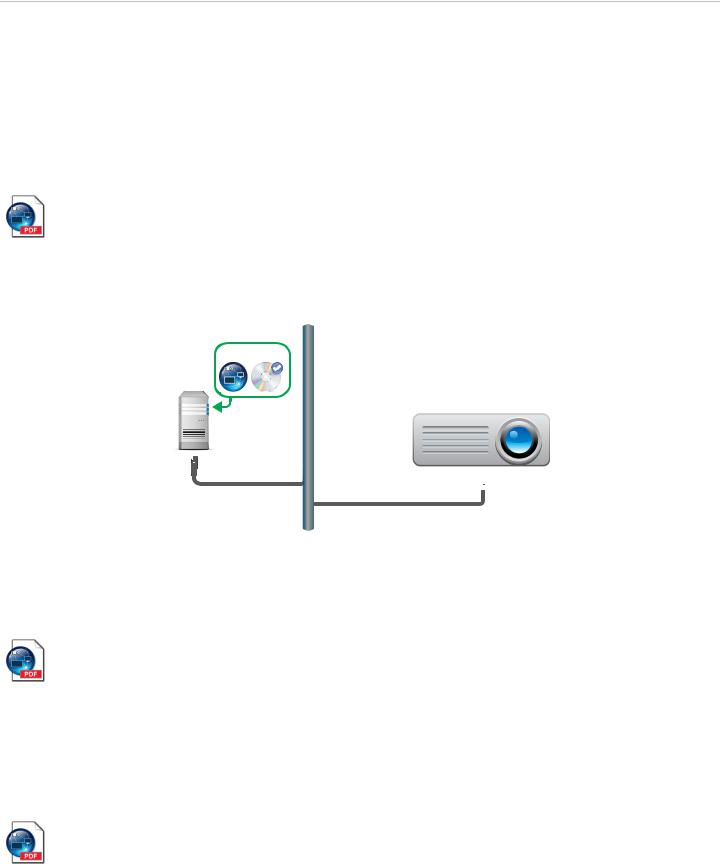
NaViSet Administrator 2 - Quick Start Guide
The following configurations using the LAN to RS232 Bridge or RS232 WMI Provider are explained in detail in chapter 4 of the User's Guide:
•NEC large-screen display(s) using LAN to RS232 Bridge
•NEC large-screen display(s) with LAN hub using LAN to RS232 Bridge
•NEC large-screen display(s) using RS232 WMI Provider
•NEC large-screen display(s) with SBC and dual LAN connections
•NEC large-screen display with SBC and single LAN connection
See Appendix A, "Comparison of connection methods for NEC large-screen displays" in User's Guide
2.3. NEC Projectors
N
E
T
W
O
R
K
LAN 
Key Points:
•The network settings must be set correctly in the projector's on-screen display.
•The communications type may need to be set specifically to LAN in the projector settings.
See chapter 4, "Configuring Devices: NEC projector with direct LAN or wireless connection" in User's Guide
Additional Projector Configuration Types
NaViSet Administrator can also communicate with NEC projectors connected to Windows computers via RS232. This is done by installing the LAN to RS232 Bridge software on the computer, allowing NaViSet Administrator to communicate with the projector using the IP address of the computer.
See chapter 4, "Configuring Devices: NEC projector connected via Windows
Computer to LAN" in User's Guide
English - 10

NaViSet Administrator 2 - Quick Start Guide
3. Mapping the Network
Creating a network in NaViSet Administrator involves adding Windows computers and NEC display devices to the device tree, and creating groups to keep them organized.
Example of devices grouped by department
3.1. Creating Groups
Groups are a way to organize collections of Windows computers and NEC devices in the device tree in a logical way. Groups are essentially named "folders" of the tree containing one or more other groups, computers or NEC devices. You can add as many groups as you like and rearrange them using drag-and- drop. You can also move computers and devices between groups.
Groups are shown in the Device Tree using a common folder icon  .
.
To add a new group:
1.A group must always belong to a parent group. Right-click on the parent for the new group and select Add Group in the context menu, or, select a parent group and click  .
.
English - 11

NaViSet Administrator 2 - Quick Start Guide
2. Enter a name and optional description and click OK.
 See chapter 2, "User Interface Overview: Groups" in User's Guide
See chapter 2, "User Interface Overview: Groups" in User's Guide
3.2. Adding Single Devices
Single devices are added using the Add Single Device dialog. Below are Quick Start instructions for adding NEC displays, projectors and Windows computers to the device tree one at a time.
To add a NEC large-screen display connected directly to your LAN:
1.Click  , or, right-click on a group in the device tree and select Add Single Device.
, or, right-click on a group in the device tree and select Add Single Device.
2.Select the device type NEC large-screen display connected to LAN.
3.Enter the IP Address of the display.
4.Click in the Monitor ID text box and enter the monitor ID of the display. If you do not know the monitor ID, leave on Auto-Detect.
5.Click Test.
English - 12

NaViSet Administrator 2 - Quick Start Guide
6.Repeat steps 3 through 5 as needed until the Connection OK! message appears, then click OK. The large-screen display will be added to the device tree and a query will be initiated to read the basic display information.
To add a NEC desktop display connected to a Windows computer on your LAN:
Note: The DDC/CI WMI Provider software should be installed on the computer prior to using this procedure.
1.Click  , or, right-click on a group in the device tree and select Add Single Device.
, or, right-click on a group in the device tree and select Add Single Device.
2.Select the device type Windows computer on LAN (WMI).
3.Enter the IP Address or host name of the computer. If unknown, click Browse.
4.If you want to connect to the computer using different credentials, select Use Library Credential to use a predefined credential. Otherwise choose Device-specific Credential and click Edit to create a new credential. See Credential Library for more information.
5.Click Test.
6.Repeat steps 3 through 5 as needed until the Connection OK! message appears, then click OK. Note: The computer and all attached displays will be added to the device tree simultaneously.
English - 13

NaViSet Administrator 2 - Quick Start Guide
To add a NEC projector connected directly to your LAN:
1.Click  , or, right-click on a group in the device tree and select Add Single Device.
, or, right-click on a group in the device tree and select Add Single Device.
2.Select the device type NEC Projector connected to LAN.
3.Enter the IP Address of the projector.
4.Click Test.
5.Repeat steps 3 through 4 as needed until the Connection OK! message appears, then click OK.
 See chapter 3, "Devices: Adding Single Devices" in User's Guide
See chapter 3, "Devices: Adding Single Devices" in User's Guide
3.3. Adding Daisy Chains of NEC large-screen displays
A daisy chain host is a NEC display connected to your LAN with one or more other large-screen displays connected to it using RS232 or LAN. Once added to the network, NaViSet Administrator can control all of the displays in the daisy chain.
The following are Quick Start instructions for adding a daisy chain host.
English - 14
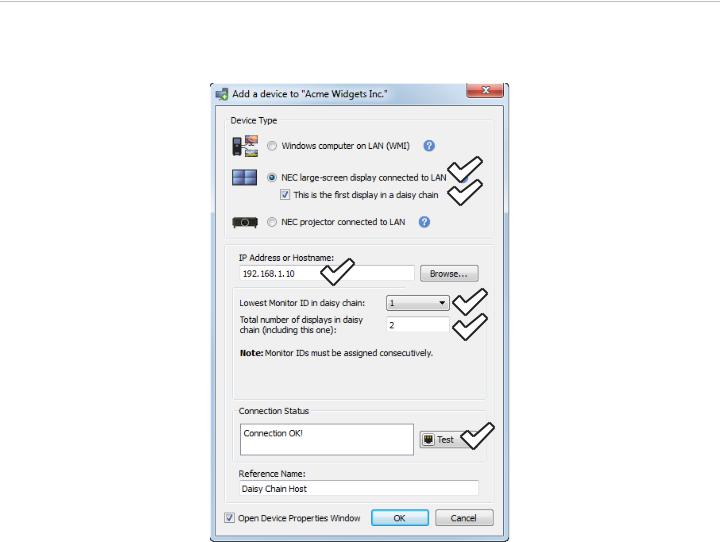
NaViSet Administrator 2 - Quick Start Guide
Note: Although this procedure can be used for display models that use LAN daisy chaining, using the Add Multiple Devices dialog to add these units by IP address results in faster communications and is therefore strongly recommended.
1.Click  , or, right-click on a group and select Add Single Device.
, or, right-click on a group and select Add Single Device.
2.Select the device type NEC large-screen display connected to LAN, and check the This is the first display in a daisy chain box.
3.Enter the IP address of the display that is connected to the LAN.
4.Select the lowest Monitor ID that is used in the daisy chain and the total number of displays in the daisy chain.
5.Click in the Monitor ID text box and enter the monitor ID of the display. If you do not know the Monitor ID, leave on Auto-Detect.
6.Click Test.
7.Repeat steps 3 through 6 as needed until the Connection OK! message appears, then click OK. All of the large-screen displays in the daisy chain will be added to the device tree.
 See chapter 3, "Devices: Adding Single Devices" in User's Guide
See chapter 3, "Devices: Adding Single Devices" in User's Guide
English - 15

NaViSet Administrator 2 - Quick Start Guide
3.4. Adding Multiple Devices
If you need to add a large number of devices it is usually easier and more efficient to add them all at once using one of the multiple device methods. This is accomplished through the Add Multiple Devices dialog.
Note: Do not use this method for adding a group of large-screen displays that are daisy-chained using RS232. See Adding Daisy Chains for more information.
Multiple devices can be added in several different ways:
•IP address range
•Import from text file or spreadsheet
•Import from another NaViSet Administrator database
•Network enumeration
•Active Directory (computers only)
Below are Quick Start instructions for adding several large-screen displays with IP addresses 192.168.1.10 through 192.168.1.20.
1.Click  , or, right-click on a group and select Add Multiple Devices.
, or, right-click on a group and select Add Multiple Devices.
2.Select the tab NEC large-screen displays.
3.Click the IP Address Range button and enter the lowest and highest IP Addresses that cover the range of devices you want to add.
4.Select Add to Table to add the devices to the table without testing the connections. Select Locate+Add to Table to test each connection as the device is added to the table.
English - 16
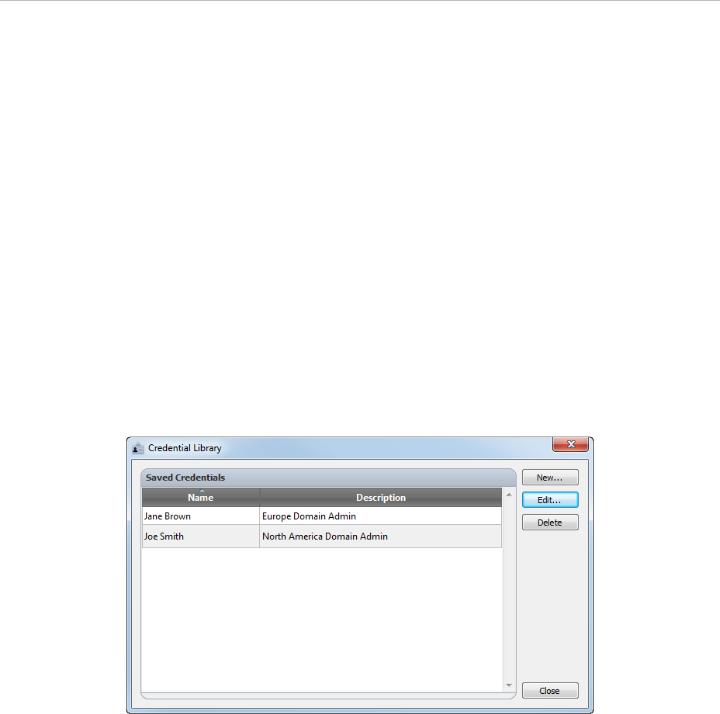
NaViSet Administrator 2 - Quick Start Guide
5.Review the resulting list and check or uncheck the boxes in the first column to include or exclude certain devices.
6.Select Existing Group to add the devices to an already existing group, or, Select New Group and enter a name to create a new group.
7.Click Apply. The devices will be added to the device tree and queries will be initiated to read the basic display information.
 See chapter 3, "Devices: Adding Multiple Devices" in User's Guide
See chapter 3, "Devices: Adding Multiple Devices" in User's Guide
3.5. Credential Library
Access credentials must be specified when connecting to remote Windows computers. These credentials must be for a user with sufficient access permissions for administering the computer and accessing WMI. The credentials consist of a Username and Password.
NaViSet Administrator has a Credential Library feature for managing credentials and making it easier to store and apply credentials for accessing multiple computers.
To open the Credential Library, click  , or, select Credential Library in the Devices menu.
, or, select Credential Library in the Devices menu.
Credential Library dialog
 See chapter 6, "Credential Library" in User's Guide
See chapter 6, "Credential Library" in User's Guide
English - 17
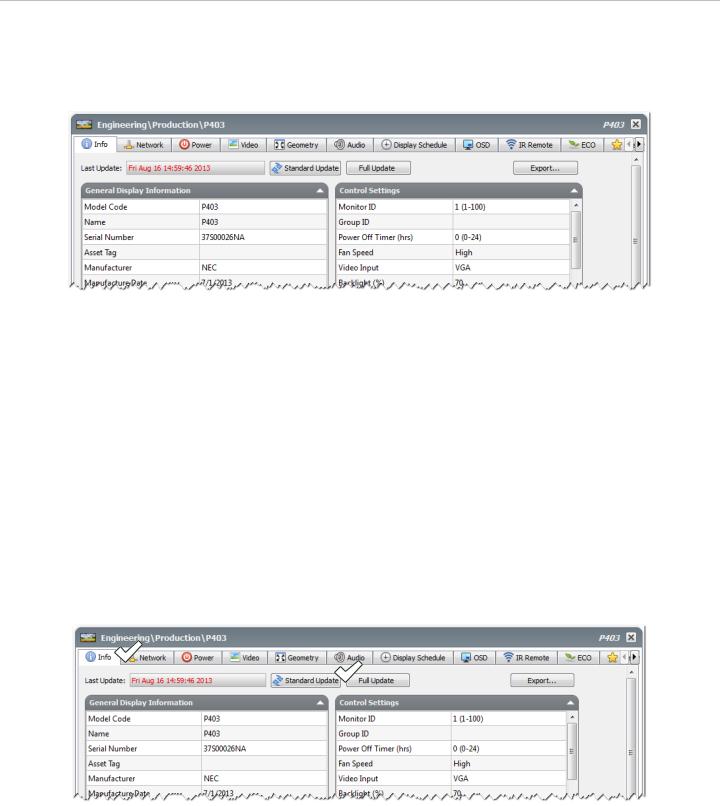
NaViSet Administrator 2 - Quick Start Guide
4. Querying and Controlling Devices
Information about the devices and their current control settings are displayed in Device Properties Windows. You can also control your NEC devices interactively through Device Properties Windows.
Example: Device Properties window
To open the Device Properties window for a device double-click on the device in the device tree, or, right-click on the device and select Properties from the context menu.
Note: Device Properties windows are displayed in the dock window area by default.
Any number of Device Properties Windows can be open at one time, but only one window per device is supported.
4.1. Querying Devices
Devices can queried to retrieve their latest information and store it in the database through the Device Properties Window.
To update the device information:
1.Double-click on the device in the device tree, or right-click on the device and select Properties from the context menu. A new Device Properties window will open showing the last settings stored in the database.
English - 18

NaViSet Administrator 2 - Quick Start Guide
2.In the Info tab note the time stamp and, if necessary, click Standard Update to update the database with the basic device information and status. Click Full Update to include all of the current control settings.
Note: The device must be powered on in order to read all of its information.
The time stamp will appear in red if it is more than 24 hours old.
4.2. Controlling Devices
The interactive control of a device is accomplished through it's Device Properties Window. Frequently used controls are separated into a series of tabbed categories such as Power, Video, and Geometry. You can also access all of the controls supported by the device through the Custom tab.
Example: Changing a common control setting
Below are Quick Start instructions for locking out the OSD to prevent adjustments using the control keys on the display.
Note: Make sure devices are fully powered on before making any setting or control adjustments.
1.Open the Device Properties window for the device by double-clicking on the device in the device tree, or right-clicking on the device and selecting Properties from the context menu.
2.Select the OSD tab. When you click on a tab the current settings are retrieved from the device in real time.
3.Click the Lock button in the Key Lock control. Commands are sent to the device in real-time.
English - 19

NaViSet Administrator 2 - Quick Start Guide
Example: Changing an uncommon control setting
Not all controls are included in the tabs of the Device Properties Window, as the number of controls supported in NEC displays are numerous. Most controls however, can be accessed through the Custom tab.
Below are Quick Start instructions for changing the side border gray scale to near black.
Note: Make sure devices are fully powered on before making any setting or control adjustments.
1.Open the Device Properties window for the device and select the Custom tab.
2.Locate the Side Border Color control in the Controls list, and click on it. The control will be added to the Settings list and it's current value will be read in real-time.
3.Click and drag the slider to the desired value and release. The new value will be sent to the display in real-time.
4.Optional: Click Save List to save the current list of controls so they will be opened automatically whenever the Custom tab is selected for this device.
English - 20
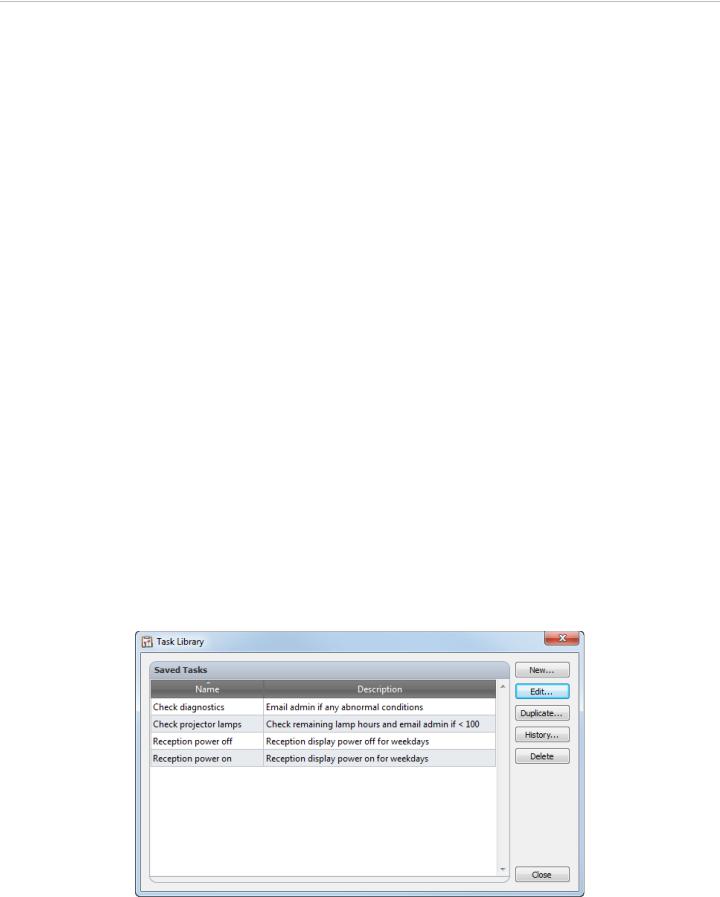
NaViSet Administrator 2 - Quick Start Guide
5. Creating and Running Tasks
Tasks are operations that can query or perform commands on one or more devices. Tasks can be scheduled to run at particular times, or on demand, and also to continue running for specific periods of time and intervals.
There are 3 basic types of tasks that can be performed in NaViSet Administrator:
•Command Tasks: Change settings or perform operations on devices. For example: Turning the display power on, selecting a particular video input, or selecting a particular channel on the TV tuner. Command Tasks can also be used to create a preset configuration of multiple settings that can be then sent to displays to allow easy configuration.
•Conditional Tasks: Read one or more settings or parameters from devices at periodic intervals, and issue alerts if the value of one or more are outside of a specified range or value, or changes in value. For example an alert can be issued if the internal temperature of a display exceeds a specific value, or if there is a diagnostic error condition reported by a display.
•Informational Tasks: Read one or more settings or parameters from devices at periodic intervals, and displays the readings in real time. An example use would be to monitor the internal temperature of a display.
When a Task is run it will attempt to perform the specified operation on each of the devices selected in the Task before completing. For Conditional and Informational type Tasks, the task can be set to poll the devices a specific intervals either indefinitely or for a specific run time.
For all types of Tasks, the result history of each operation is stored in the database and can be viewed both while the Task is being performed, as well as reviewed later. Task history can also be exported via the clipboard, an Excel spreadsheet, or delimited text file.
Task Library
All tasks can be managed using the Task Library. Tasks can be created, edited, duplicated, and deleted from within the Task Library. The execution history of a task can be viewed and exported.
To open the Task Library, click  , or, select Task Library in the Tasks menu.
, or, select Task Library in the Tasks menu.
Task Library dialog
English - 21

NaViSet Administrator 2 - Quick Start Guide
Task Manager
The Task Manager window is divided into 3 sections, Inactive Tasks, Active Tasks, and Alerts.
Task Manager dock window
Inactive Tasks
The Inactive Tasks table shows the tasks defined in the database that are not running. When you create new tasks they are added to this table. Several task operations can be initiated from the Inactive Tasks table:
•Click  to open the Task Properties dialog to view or edit the task.
to open the Task Properties dialog to view or edit the task.
•Click  to open the Task History Viewer window to view the results of previous run tasks.
to open the Task History Viewer window to view the results of previous run tasks.
•Click the checkbox in the Next Start Time cell to toggle the starting option between scheduled and unscheduled.
•Click  to start the task manually.
to start the task manually.
Active Tasks
The Active Tasks table shows the tasks defined in the database that are running. When started either manually or automatically, the task will move from the Inactive Tasks table to the Active Tasks table. Upon completion or termination the task will move back to the Inactive Tasks table. Several task operations can be initiated from the Active Tasks table:
•Click  to open the Task Viewer window and monitor the running task in real-time.
to open the Task Viewer window and monitor the running task in real-time.
•Click  to stop the task.
to stop the task.
English - 22

NaViSet Administrator 2 - Quick Start Guide
Alerts
The Alerts Table shows any alert messages generated from conditional tasks. All alert messages are saved in the database until they are removed from the table by clicking the Clear button.
Note: Alerts generated during the current session will appear in red text, and alerts from previous sessions will use the standard text color.
 See chapter 7, "Tasks" in User's Guide
See chapter 7, "Tasks" in User's Guide
5.1. Creating Tasks
Tasks can be created using a step-by-step wizard interface in the Task Builder Wizard available on the Tasks menu, or by clicking the Task Builder Wizard button. The wizard offers a guided explanation of each step of creating a task.
Tasks can also be created directly by selecting New Task on the Tasks menu, or by clicking the New Task button, or by selecting New from the Task Library.
 See chapter 7, "Tasks: Creating Tasks" in User's Guide
See chapter 7, "Tasks: Creating Tasks" in User's Guide
Command Tasks
Command Tasks are used to change the settings of your NEC devices. Below are Quick Start instructions for creating a Command Task.
2 |
3 |
4 |
5 |
6 |
7 |
8 |
9 |
1.Click  , or, select New Task from the Tasks menu.
, or, select New Task from the Tasks menu.
2.In the Settings tab, enter a name for the task. The description is optional. Make sure the Command task type is selected.
3.Click on the Devices tab and check the boxes next to all of the devices you want to include in this task.
English - 23
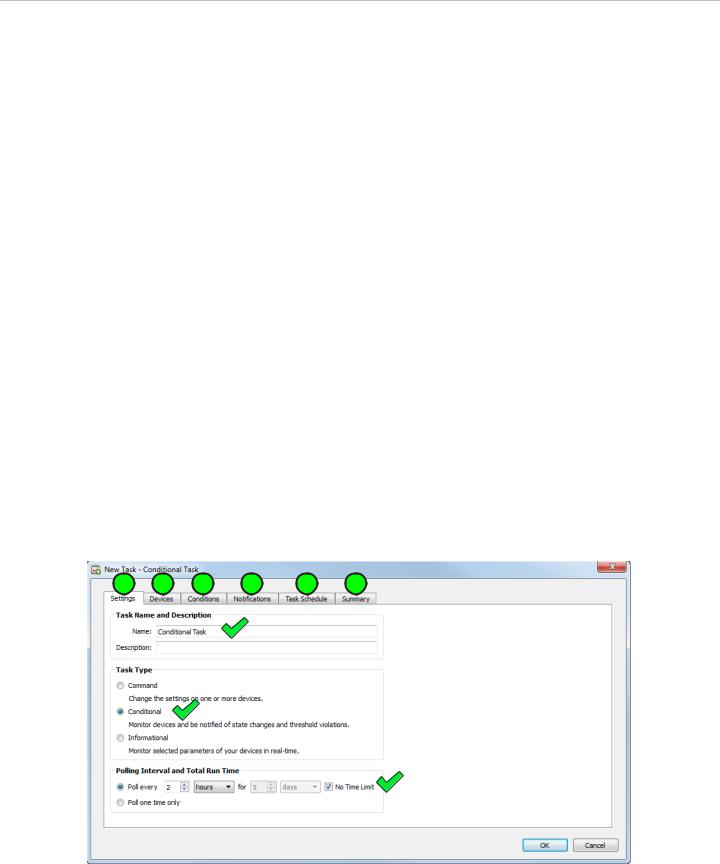
NaViSet Administrator 2 - Quick Start Guide
4.Click on the Commands tab, and for each command you want to send:
•Locate the control in the tree list and click on it. The control will be added to the Commands list.
•Set the control's value.
5.Optional: Click on the Display Schedule tab if you want to set scheduling within the device.
6.Optional: Click the IR Remote tab if you want this task to send one or more IR Remote commands.
7.Optional: Click on the Notifications tab page if you want to be notified by email of the completion status or warnings encountered during runtime.
8.Optional: Click on the Schedule tab page if you want to schedule the task to start at periodic intervals.
9.Optional: Click on the Summary page to view all of the task settings, then click OK.
Once a task is created it will be listed in the Inactive Tasks table in Task Manager.
 See chapter 7, "Tasks: Creating a New Command Task" in User's Guide
See chapter 7, "Tasks: Creating a New Command Task" in User's Guide
Conditional Tasks
Conditional Tasks are used to check the settings or parameters of devices at periodic intervals and issue alerts if values are outside a specified range or are changed. Below are Quick Start instructions for creating a Conditional Task.
2 |
4 |
5 |
6 |
7 |
8 |
1. Click  , or, select New Task from the Tasks menu.
, or, select New Task from the Tasks menu.
English - 24
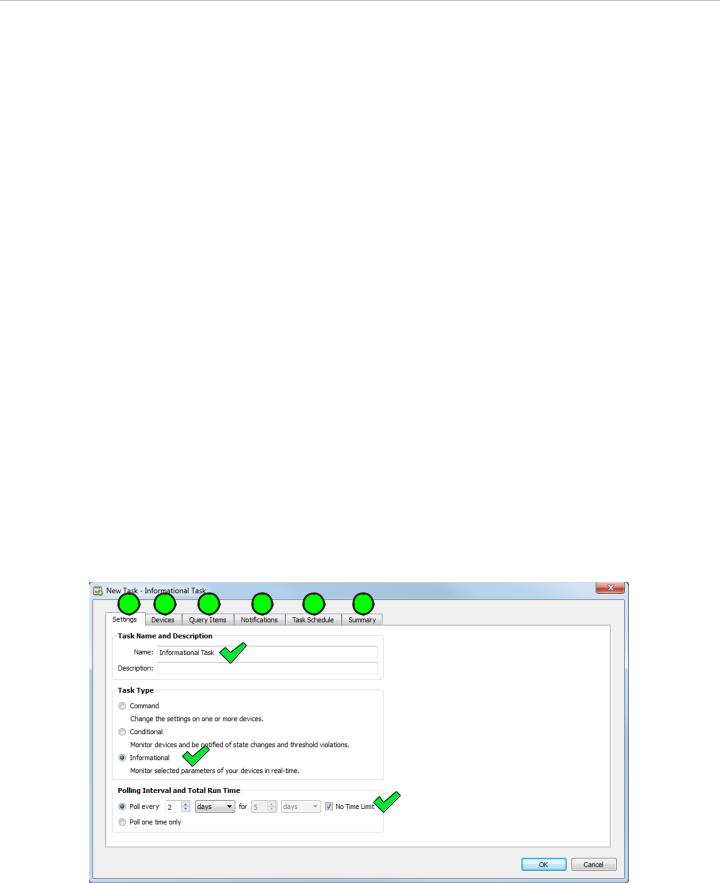
NaViSet Administrator 2 - Quick Start Guide
2.In the Settings tab, enter a name for the task. The description is optional.
3.Select the Conditional task type, and how often you want to query the devices.
4.Click on the Devices tab and check the boxes next to all of the devices you want to include in this task.
5.Click on the Conditions tab, and for each setting you want to check:
•Locate the setting in the tree list and click on it. The control will be added to the Conditions list.
•Adjust the controls to create the desired conditional expression.
6.Optional: Click on the Notifications tab page if you want to be notified by email of alert conditions, completion status, or warnings encountered during runtime.
7.Optional: Click on the Schedule tab page if you want to schedule the task to start at periodic intervals.
8.Optional: Click on the Summary page to view all of the task settings, then click OK.
Once the task is created it will be added to the Inactive Tasks table in Task Manager.
 See chapter 7, "Tasks: Creating Conditional Tasks" in User's Guide
See chapter 7, "Tasks: Creating Conditional Tasks" in User's Guide
Informational Tasks
Use Informational Tasks to read one or more settings or parameters from devices at periodic intervals and display the readings in real time. Below are Quick Start instructions for creating a Informational Task.
2 |
4 |
5 |
6 |
7 |
8 |
English - 25

NaViSet Administrator 2 - Quick Start Guide
1.Click  , or, select New Task from the Tasks menu.
, or, select New Task from the Tasks menu.
2.In the Settings tab, enter a name for the task. The description is optional.
3.Select the Informational task type, and how often you want to query the devices.
4.Click on the Devices tab and check the boxes next to all of the devices you want to include in this task.
5.Click on the Query Items tab and for each setting you want to read locate the item in the tree list and click on it. The item will be added to the Query Items list.
6.Optional: Click on the Notifications tab page if you want to be notified by email of completion status or warnings encountered during runtime.
7.Optional: Click on the Task Schedule tab page if you want to schedule the task to start at periodic intervals.
8.Optional: Click on the Summary page to review all of the task settings, then click OK.
Once the task is created it will be added to the Inactive Tasks table in Task Manager.
 See chapter 7, "Tasks: Creating Informational Tasks" in User's Guide
See chapter 7, "Tasks: Creating Informational Tasks" in User's Guide
Email Notifications
Email Notifications allow the application to inform one or more individuals of the status of a task through email. For example an administrator may want to be notified when a very long task involving a hundreds of devices has completed, or if an abnormal condition was detected during the operation. All tasks types allow you to add email notifications.
The following are Quick Start instructions for adding an alert email notification while creating a new task.
English - 26

NaViSet Administrator 2 - Quick Start Guide
1.Click on the Notifications tab page and click Add a Notification.
2.Click in the Notification Type combo box and select Email Message.
3.In the Notification Settings dialog enter the email address of the recipient. You can also enter a Supplemental Message which will be added to the end of all email messages.
4.Click OK to close the Notification Settings dialog.
5.Check the Alert Conditions check box.
 See chapter 7, "Tasks: Notifications Tab" in User's Guide
See chapter 7, "Tasks: Notifications Tab" in User's Guide
Scheduling Tasks
The Task Schedule Tab is used to set how and when the task is started. Tasks can be set to run On Demand (manually started) or Scheduled to run at a set time interval. Temporary tasks must be started manually and exist only during the currently opened session of NaViSet Administrator. Scheduling is supported for all tasks types.
The following are Quick Start instructions for scheduling the task to start every other Monday at 5:00AM.
English - 27
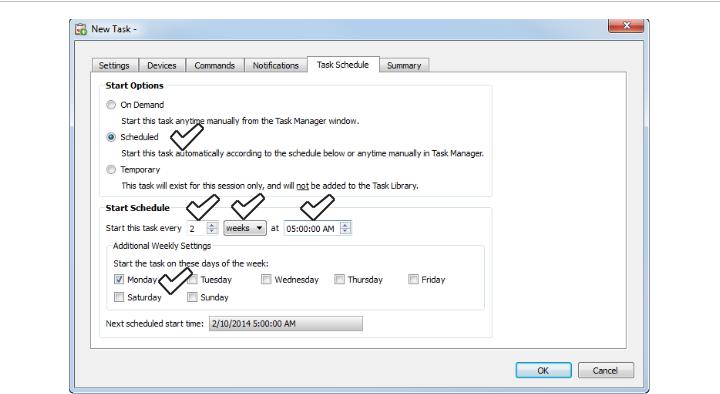
NaViSet Administrator 2 - Quick Start Guide
1.Click on the Task Schedule tab page and select the Scheduled start option.
2.Adjust the Start Schedule controls as shown above.
 See chapter 7, "Tasks: Task Schedule Tab" in User's Guide
See chapter 7, "Tasks: Task Schedule Tab" in User's Guide
5.2. Running Tasks
When you create a task you are actually creating a task script which is saved to the database. The task must then be run in order to perform the operations for which it was intended.
Tasks can be started either On Demand or they can be Scheduled to start automatically.
To start a task On Demand:
1.Click the task's  button in the Inactive Tasks table in Task Manager.
button in the Inactive Tasks table in Task Manager.
2.Optional: Click  in the Active Tasks table to open the Task Viewer Window and monitor the task in real-time.
in the Active Tasks table to open the Task Viewer Window and monitor the task in real-time.
3.Optional: Click  in the Active Tasks table to stop the task.
in the Active Tasks table to stop the task.
English - 28

NaViSet Administrator 2 - Quick Start Guide
5.3. Task History
By default, all task results are saved to the database upon completion. You can then view, export, or delete the task results at a future time using the Task History Viewer.
To open the Task History Viewer, click  in the Inactive Tasks table in Task Manager.
in the Inactive Tasks table in Task Manager.
Task History Viewer dock window
Several operations can be initiated from the Task History Viewer:
•Select a specific version of the task results by selecting its completion date and time in the Show Task Ending On drop-down list.
•Click the Delete button to permanently delete the selected version of the task results from the database.
•Click the Export button to output the selected version of the task results to a spreadsheet or text file.
•Select a specific device type in the Task Data table to filter out all other devices.
•Check Enable Column Sorting and click in any column to sort the table by column.
 See chapter 7, "Tasks: Task History" in User's Guide
See chapter 7, "Tasks: Task History" in User's Guide
English - 29
